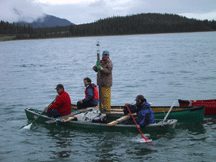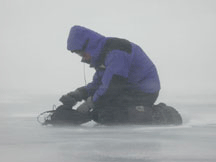|
Documenting Holocene Paleohydrology Using Multiproxy Lake Core Studies in the Yukon Territory, Canada - Collaborators include Lesleigh Anderson, Bruce Finney, Mary Edwards, David Pompeani, Byron Steinman, Nathan Stansell, Dan Nelson among others
This research has two goals: (1) produce high-resolution multiproxy records documenting changes in the regional precipitation-evaporation (P-E) balance during the Holocene from laminated lakes and (2) expand southeastward the network of sites with paleohydrological data that have been studied to date in Alaska. A major objective of this project is to identify the causes of shifts in the P-E balance during the late Pleistocene and Holocene in the upper reaches of the Yukon River watershed. Lake systems at both ends of the hydrologic spectrum are included in this study: (1) closed basin lakes and (2) overflowing lakes with large positive water balances and high watershed to lake area ratios. Past experience in the region shows an integrated study of open- and closed-basin sites is necessary to obtain paleoclimate records for the last ca. 15 ka, because there have been large changes in the P-E balance from the late Pleistocene to the present. D and O-18 measurements on modern surface waters across the region illustrate two points: (1) the proposed closed basin sites are sensitive to changes in the P-E and (2) the open basins have lake water that plots on the Local Meteoric Water Line (LMWL) indicating the effects of evaporation are minimal. Previous work based on pollen studies provides a broad paleoclimatic picture for this period. However, significant paleoclimatic questions remain unanswered, and high-resolution (< century-scale) climate reconstructions have not been attempted.
Resulting publications include
Late Holocene Moisture Balance Variability in the Southwest Yukon Territory, Canada. Analyses of sediment cores from Marcella Lake, a small, hydrologically closed lake in the semi-arid southwest Yukon, provides effective moisture information for the last ~4500 years at century-scale resolution. Water chemistry and oxygen isotope analyses from lakes and precipitation in the region indicate that Marcella Lake is currently enriched in 18O by summer evaporation. Past lake water values are inferred from oxygen isotope analyses of sedimentary endogenic carbonate in the form of algal Charophyte stem encrustations. A record of the d18O composition of mean annual precipitation at Jellybean Lake, a nearby evaporation-insensitive system, provides data of simultaneous d18O variations related to decade-to-century scale shifts in Aleutian Low intensity/position. The difference between the two isotope records, Dd, represents 18O-enrichment in Marcella Lake water caused by summer effective moisture conditions. Results indicate increased effective moisture between ~3000 and 1200 cal BP and two marked shifts toward increased aridity at ~1200 and between 300 and 200 cal BP. These prominent late Holocene changes in effective moisture occurred simultaneously with changes in Aleutian Low circulation patterns over the Gulf of Alaska indicated by Jellybean Lake. The reconstructed climate patterns are consistent with the topographically controlled climatic heterogeneity observed in the coastal mountains and interior valleys of the region today.
Palaeohydrology of the Southwest Yukon Territory, Canada, Based on Multiproxy Analyses of Lake Sediment Cores from a Depth Transect. Lake-level variations at Marcella Lake, a small, hydrologically closed lake in the southwestern Yukon Territory, document changes in effective moisture since the early Holocene. Former water levels, driven by regional palaeohydrology, were reconstructed by multiproxy analyses of sediment cores from four sites spanning shallow to deep water. Marcella Lake today is thermally stratified, being protected from wind by its position in a depression. It is alkaline and undergoes bio-induced calcification. Relative accumulations of calcium carbonate and organic matter at the sediment_/water interface depend on the location of the depositional site relative to the thermocline. We relate lake-level fluctuations to down-core stratigraphic variations in composition, geochemistry, sedimentary structures and to the occurrence of unconformities in four cores based on observations of modern limnology and sedimentation processes. Twenty-four AMS radiocarbon dates on macrofossils and pollen provide the lake-level chronology. Prior to 10 000 cal. BP water levels were low, but then they rose to 3 to 4 m below modern levels. Between 7500 and 5000 cal. BP water levels were 5 to 6 m below modern but rose by 4000 cal. BP. Between 4000 and 2000 cal. BP they were higher than modern. During the last 2000 years, water levels were either near or 1 to 2 m below modern levels. Marcella Lake water-level fluctuations correspond with previously documented palaeoenvironmental and palaeoclimatic changes and provide new, independent effective moisture information. The improved geochronology and quantitative water-level estimates are a framework for more detailed studies in the southwest Yukon.
Regional Atmospheric Circulation Change in the North Pacific During the Holocene Inferred from Lacustrine Carbonate Oxygen Isotopes, Yukon Territory, Canada. Analyses of sediment cores from Jellybean Lake, a small, evaporation-insensitive groundwater-fed lake, provide a record of changes in North Pacific atmospheric circulation for the last 7500 yr at 5- to 30-yr resolution. Isotope hydrology data from the southern Yukon indicate that the oxygen isotope composition of water from Jellybean Lake reflects the composition of mean-annual precipitation, y18Op. Recent changes in the d18O of Jellybean sedimentary calcite (y18Oca) correspond to changes in the North Pacific Index (NPI), a measure of the intensity and position of the Aleutian Low (AL) pressure system. This suggests that d18Op variability was related to the degree of fractionation during moisture transport from the Gulf of Alaska across the St. Elias Mountains and that Holocene shifts were controlled by the intensity and position of the AL. Following this model, between 7500 and 4500 cal yr B.P., long-term trends suggest a predominantly weaker and/or westward AL. Between 4500 and 3000 cal yr B.P. the AL shifted eastward or intensified before shifting westward or weakening between 3000 and 2000 cal yr B.P. Rapid shifts eastward and/or intensification occurred 1200 and 300 cal yr B.P. Holocene changes in North Pacific atmospheric circulation inferred from Jellybean Lake oxygen isotopes correspond with late Holocene glacial advances in the St. Elias Mountains, changes in North Pacific salmon abundance, and shifts in atmospheric circulation over the Beaufort Sea.
A Sedimentary and Geochemical Record of Water-Level Changes from Rantin Lake, Yukon, Canada. A multi-proxy analysis of two sediment cores from Rantin Lake are used to reconstruct past lake-level changes and to make inferences about millennial-scale variations in precipitation/evaporation (P/E) balance in the southern Yukon, Canada between 10,900 and 3,100 cal yr BP. Analyses of calcium carbonate and organic matter concentration, magnetic susceptibility, titanium content, dry bulk density, and macrofossils are used to reconstruct water-level changes. The development of sand layers and deformed sediments at the deep-water core site (i.e. Core A-06) prior to *10,900 cal yr BP suggest that lake level was lower at this time. Fine-grained organic sediment deposited from 10,600 to 9,500 cal yr BP indicates a rise in lake level. The formation of an unconformity at the shallow cores site (Core C-06) and the deposition of shallow-water calcium carbonate-rich facies at the Core A-06 site between *9,500 and *8,500 cal yr BP suggest lower lake levels at this time. Shallow-water facies gradually transition into a sand layer that likely represents shoreline reworking during an extreme lowstand that occurred at *8,400 cal yr BP. Following this low water level, fine-grained organic-rich sediment formed by *8,200 cal yr BP, suggesting deeper water conditions at core site A-06. Calcium carbonate concentrations are relatively low in sediment deposited from *6,300 to 3,100 cal yr BP in Core A-06, indicating that lake level was comparatively higher during the middle and late Holocene. In general, results from this study suggest that the early Holocene was characterized by high P/E from *10,500 to 9,500 cal yr BP, low P/E from *9,500 to 8,400 cal yr BP, and return to higher P/E from *8,200 to 3,100 cal yr BP.
|



